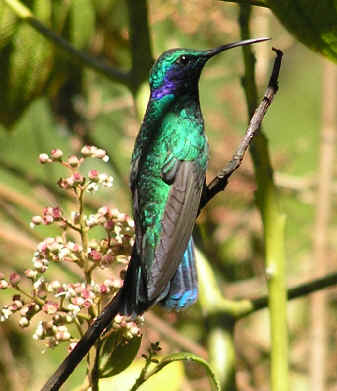Last time, here, and also
in the Birdline prior to that, PURPLE GALLINULES were noted
as being in the area of the Great Lakes.
First, at the beginning of October, by Lake
Ontario, at Sodus Point, New York.
Then, on October 9, by Lake Erie, at Presque
Isle, in Erie, Pennsylvania.
Also, a PURPLE GALLINULE was at Port Weller, Ontario,
on October 10 & 11.
And yesterday, October 20, not by a Great Lake, but near the
great port of New York City, an immature PURPLE GALLINULE was
found in Bayonne, New Jersey, by the Lefante
Walkway.
PURPLE GALLINULES are normally further south in places like
Florida, Louisiana, and Texas.
Normally even further south is the hummingbird called the GREEN
VIOLETEAR. One was in Cecil County, Maryland,
recently, but only for a short while, and not seen by many people.
It was, however, photographed.
The GREEN VIOLETEAR is a Neotropical species, most often in the
highlands, from Mexico south to northern South America. Most
occurrences in the United States have been in the Hill Country of
Texas, where it is nearly annual. It has also occurred
rarely in eastern North America and elsewhere in the US.
Since the 1960s, there have been over 40 records of the GREEN
VIOLETEAR in eastern Texas, with as many as 4
during one season. These have been in the Edwards Plateau (or the
"Hill Country" as just noted), and along the Gulf Coast
and in the lower Rio Grande Valley. All of the occurrences of the
species north of Mexico in the spring have been in Texas.
Accepted records of the GREEN VIOLETEAR, in addition to those in
Texas, have been in these US sttes and Canadian provinces:
Alabama, Alberta, Arkansas, Colorado, Kentucky, Louisiana,
Michigan, Mississippi. North Carolina, Ohio, Oklahoma, Ontario,
Wisconsin.
These north-of-range records have been from mid-April through
mid-December, with most from early May to late July, and with a
minor peak in late August and early September.
This seasonal pattern may be of adults and young birds following
the spring breeding season or the dispersal of young adults prior
to the summer breeding season.
Many sightings are "one day wonders", but the average
sighting period has been 2 weeks. The longest sighting period at
a single location was 18 weeks.
Anyway, add Maryland to the above list of states, and
plug in October for the month.
Last time, here, a sighting was mentioned of a BELL'S VIREO in
Maryland, along the seacoast, at Assateague Island, on October 8.
This past week, there was another BELL'S VIREO found in Maryland
on October 17. It was in the same county as the VIOLETEAR, Cecil
County, in extreme northeast Maryland. The BELL'S
VIREO was at a place called Turkey Point, at the top of the
Chesapeake Bay.
The BELL'S VIREO occurs, during its breeding season, in
shrubby habitats in the midwest and southwest US, and northern
Mexico. In the winter, most, in fact nearly all, are further
south along the Pacific coast of Mexico.
Since the 1960s, the population of the species has declined by
more than 50 per cent. It is now classified as
"near-threatened" by Birdlife International.
Last time, here, a NORTHERN WHEATEAR was told of in Pennsylvania.
On October 11, another NORTHERN WHEATEAR was found in New
Hampshire, near the summit of Mount Moosilauke. Now
that's quite a name.
Also seen there that day, at that New Hampshire mountain,
were:
GOLDEN EAGLE, AMERICAN GOLDEN PLOVER, 2 LAPLAND LONGSPURS, 5
AMERICAN PIPITS, a BLACKPOLL WARBLER, and several RUBY-CROWNED
KINGLETS. A nice mix.
Back in Lebanon County, Pennsylvania, where last
week's WHEATEAR was, 221 AMERICAN PIPITS were counted at a
pond by Mount Pleasant Road. One can assume that was not an
estimate.
Also in south-central Pennsylvania, a BLACK RAIL was found in Cumberland
County on October 16. In a small wetland, after the bird was
flushed, it fluttered, and glided, and disappeared, not to be seen
again.
In northwest Pennsylvania, a couple birds normally further west
were seen this past week: a FRANKLIN'S GULL on October 17, and
a WHITE-WINGED DOVE, the previous day, October 16, both at
Presque Isle, in Erie.
Jekyll Island, along the seacoast in Georgia,
must be a place quite different than Presque Isle, Pennsylvania.
But another WHITE-WINGED DOVE was there, on October 15.
A bird in the East, from the West, was an ASH-THROATED FLYCATCHER
at a place called the Villas near Cape May, New Jersey,
on October 17.
Another ASH-THROATED FLYCATCHER has recently been in Winthrop, Massachusetts.
In the East, a westerner, a YELLOW-HEADED BLACKBIRD was on Long
Island, New York, on October 19, at the Captree
State Park.
Another YELLOW-HEADED BLACKBIRD has continued at Brigantine
National Wildlife Refuge in New Jersey.
Now, going west, to the other coast of the continent,
actually slightly beyond, offshore on the Pacific,
another WHITE-CHINNED PETREL was found on October 16 at Cordell
Bank, off California, sitting on the ocean with a
flock of NORTHERN FULMARS. It was the second WHITE-CHINNED PETREL
off California in the last few months.
Also offshore from California, there have been reports recently by
fisherman of SHORT-TAILED ALBATROSS, off Bodega Bay.
Back east, of course SANDHILL CRANES are not as common as they are
at various places in western and central North America, but there
has been a sprinkling of them, here and there, including up
to 5, recently, at Wareham, Massachusetts, in
cranberry bogs.
Sometimes, banding has shown that birds travel afar. Sometimes
not. A SANDHILL CRANE in western Pennsylvania, at
the Pymatuning State Park, in Crawford County, on October 18, was
seen to be banded.
That band indicated that the bird was banded outside Cambridge
Springs, also in Crawford County PA, on June 26, 2011.
On the opposite side of Pennsylvania, a SANDHILL CRANE
that was found in Northampton County back in mid-July, was
found again this past week, on October 18.
Now, some notes about BIRD MIGRATION now underway:
At Presque Isle, in Erie, Pennsylvania, on the
shore of Lake Erie:
On October 17, well over a thousand BONAPARTE'S GULLS passed by,
heading west.
On October 19, 815 DOUBLE-CRESTED CORMORANTS,
and on October 20, there was a large movement of 3,560 LESSER
SCAUP, between 7:30 & 7:45am.
From the State Line Lookout in New Jersey, atop
the Palisades, about 2,000 BRANT were seen migrating south along
the Hudson River, on October 20, between 9am & 3pm. They were
in multiple waves.
More than 30 PARASITIC JAEGERS were seen from the Seawatch at
Avalon, New Jersey on October 14.
In the area of the Great Lakes, there were PARASITIC
JAEGERS recently in Buffalo, New York, with
5 seen at once, and also by Lake Erie, there were 18 JAEGERS at
Hamburg, New York, on October 15.
That same day, at Squaw Island, in Buffalo, there was a
BLACK-HEADED GULL and 2 LITTLE GULLS among numerous
BONAPARTE'S GULLS.
In far upstate New York, on October 13, PINE SISKINS were in
Wanakona, feeding on the heavy cone crop in balsam fir and
tamarack
trees. But not just in Wanakona, they have been elsewhere in
northern New York as well.
Along the Maryland coast, there have been two
twosomes of CLAY-COLORED SPARROWS:
On October 14, two were at Assateague Island, with other
SPARROWS, mostly WHITE-THROATED and some WHITE-CROWNED.
On October 19, two were by Sunset Park in downtown Ocean City,
Maryland.
A threesome of AMERICAN WHITE PELICANS was seen along the Delaware
coast on October 14, at Cape Henlopen, flying north.
Across the Delaware
Bay from Henlopen is Cape May, New Jersey, and those who
have birded there may have known Dick Turner, who recently passed
away.
He was a keen birder and photographer who would, as noted in a
very impressive obituary this past week in the New York Times,
"often leap up, grab his camera and run out the front door of
his house in Cape May when he got word of a rare sighting. He
spent much of his time at the Cape May Bird Observatory, where he
was a volunteer. He was also a director of the New Jersey Audubon
Society and the Pineland Preservation Alliance."
But, as noted in that impressive obituary, he was much more,
including being an expert on the Florentine Renaissance, with his
landmark 1983 study, "Inventing Leonardo" in which he
traced the protean outlines of Leonardo da Vinci through his
interpreters over the last 500 years. "There was a 1550
Leonardo", Turner wrote, "an 1800 one, an 1850 one, and
so on".
A. Richard Turner wrote extensively about Renaissance Italy,
especially Florence. If you're interested, check it out.
I would write now, that when we meet someone in the "birding
world", we might think we know him or her, but we really
don't.
Armas Hill has presented the Birdline, originally from
Philadelphia, on the phone and internet for decades (3), and on
the radio in Delaware for years (10).
The Birdline (and the Natureline)
are affiliates of Focus On Nature Tours.
There have a number of recent updates in the FONT website.
If you haven't visited lately, you are welcome to do so:
www.focusonnature.com
By the way, the answers to the Bird
Trivia Questions here last time:
2 bird species that nest in Canada, but not
normally the US: the Harris's Sparrow, and the Common
Ringed Plover.
The US state said to be with the most dragonfly species
in one county: New Jersey, the county Sussex.


